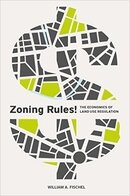Zoning has shaped American cities since 1916, when New York City adopted the first comprehensive ordinance. It has remained a popular and widely used institution, particularly for homeowners wishing to protect the value of their homes. As values have soared in recent years, however, this protection has accelerated to the degree that new housing development has become unreasonably difficult and costly. The widespread Not in My Backyard (NIMBY) syndrome is driven by voters’ excessive concern about their home values and creates barriers to growth that reach beyond individual communities. Those barriers contribute to suburban sprawl, entrench income and racial segregation, retard regional immigration to the most productive cities, add to national wealth inequality, and slow the growth of the American economy. Zoning Rules, an update of Fischel’s 1985 classic book The Economics of Zoning, examines this history while offering solutions to the unintended consequences of zoning.

